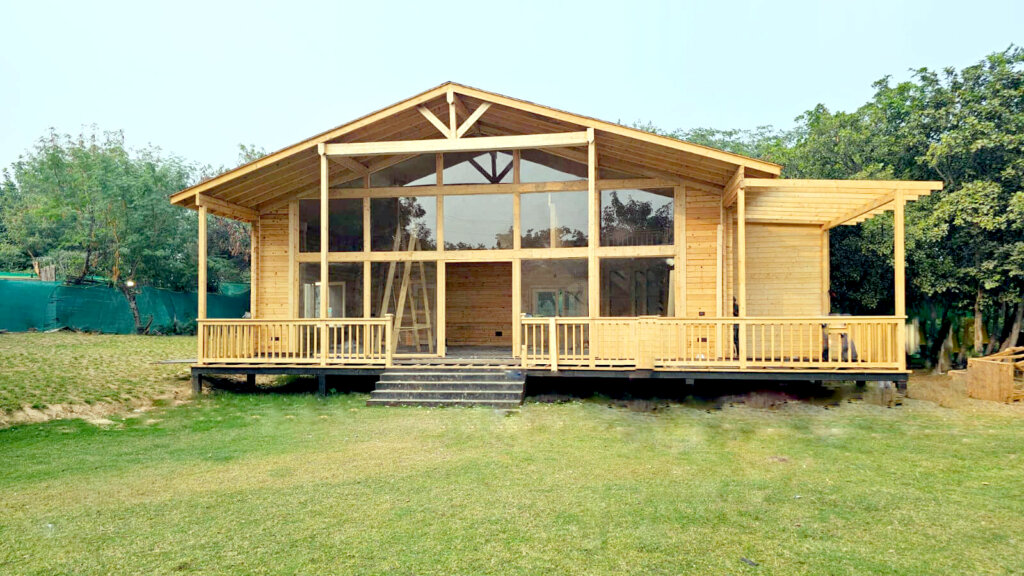
Introduction
In the face of escalating environmental challenges, the construction industry is undergoing a paradigm shift towards sustainable practices. One material that stands out for its ecological benefits is Wood. Beyond its aesthetic appeal and structural versatility, wood houses offer a plethora of environmental advantages, making them an increasingly popular choice for eco-conscious builders. This blog delves into the myriad ways in which wood houses contribute to a more sustainable and environmentally friendly future.
Renewability and Sustainable Forestry
Wood’s primary advantage lies in its renewability. Unlike non-renewable resources such as concrete and steel, which deplete the Earth’s finite reservoirs, wood is a replenishable resource. Sustainable forestry practices ensure that trees are harvested at a rate equal to or less than their growth rate. This approach guarantees the longevity of forests, maintaining biodiversity and preserving ecosystems. By opting for wood in construction, we actively participate in a cycle that allows forests to thrive and regenerate.
Sustainable forestry management involves considerations such as selective harvesting, reforestation, and biodiversity conservation. These practices ensure that the environmental impact of wood extraction is minimized, creating a harmonious balance between human needs and ecological health.
Carbon Sequestration
Wood has a unique ability to combat climate change by acting as a carbon sink. During photosynthesis, trees absorb carbon dioxide from the atmosphere and convert it into oxygen while storing carbon in their fibers. When wood is used in construction, this stored carbon remains locked away, preventing it from being released back into the atmosphere.
The carbon sequestration capacity of wood contributes significantly to mitigating climate change. Unlike carbon-intensive materials like concrete, which release large amounts of carbon during production, wood helps offset carbon emissions by storing carbon throughout its lifecycle. The choice of wood for housing becomes not just a matter of aesthetics but a proactive step in reducing our collective carbon footprint.
Energy Efficiency
Wooden houses are celebrated for their exceptional thermal insulation properties. Wood is a natural insulator, effectively regulating indoor temperatures and reducing the need for excessive heating or cooling. The thermal performance of wood outperforms many traditional building materials, leading to energy savings and increased comfort for occupants.
The energy efficiency of wood extends to its production process. Compared to energy-intensive methods required for manufacturing steel and concrete, the production of wood products requires significantly less energy. By opting for wood, we indirectly reduce the overall energy demand associated with the construction industry, contributing to a more sustainable and eco-friendly built environment.
Low Embodied Energy
Embodied energy, which encompasses the total energy consumed throughout the lifecycle of a building material, is a crucial consideration in sustainable construction. Wood has a distinct advantage in this regard, boasting lower embodied energy compared to materials like concrete and steel.
The manufacturing process for wood products, from logging to processing, consumes less energy. This lower energy demand not only reduces the environmental impact but also aligns with the principles of sustainable and responsible resource use. Choosing materials with low embodied energy is a step towards creating buildings that are environmentally conscious from their inception.
Biodegradability and Reduced Waste
Wood is inherently biodegradable, meaning it can decompose naturally at the end of its lifecycle. This stands in stark contrast to non-biodegradable materials, such as plastics and certain metals, which persist in landfills for extended periods, contributing to environmental pollution.
In addition to its biodegradability, wood construction generates less waste during the building process. The precision and modularity of wood components often result in minimal on-site waste compared to other construction materials. This characteristic aligns with the principles of a circular economy, where resources are used efficiently, and waste is minimized through careful design and construction practices.
Sustainable forestry practices, which are integral to responsible wood sourcing, contribute to the economic well-being of communities involved in the timber industry. By promoting and participating in sustainable forestry, individuals and communities contribute to the maintenance of healthy forests, the preservation of biodiversity, and the creation of local jobs.
Aesthetic and Design Flexibility
While the environmental advantages of wood are compelling, it’s important to recognize the aesthetic and design benefits that wood houses offer. Wood’s natural warmth and beauty create inviting living spaces that stand the test of time. Additionally, wood’s versatility allows for diverse architectural styles and construction methods, enabling innovative and sustainable design solutions.
Architects and designers can leverage the unique characteristics of wood to create energy-efficient, aesthetically pleasing structures that integrate seamlessly with the natural environment. The adaptability of wood as a building material opens doors to sustainable design practices that prioritize both form and function.
Conclusion
Wood houses emerge as beacons of sustainability, embodying a harmonious relationship between human shelter and environmental responsibility. From the renewability and carbon sequestration capabilities of wood to its energy efficiency, low embodied energy, and biodegradability, wood stands as a cornerstone for environmentally conscious construction.
By choosing wood, we contribute to a more sustainable built environment, one that aligns with the principles of ecological balance and responsible resource use. As the demand for sustainable construction practices grows, wood houses serve as exemplars of how the integration of nature-friendly materials can lead us towards a greener, more resilient future.
In the face of climate challenges, our choices in construction materials become pivotal in shaping the world we inhabit. Wood houses not only provide shelter but also represent a commitment to a sustainable and regenerative relationship with the environment. As we move forward, the enduring appeal of wood in construction beckons us to build not just for the present but for a future where environmental harmony is at the heart of every structure we create.